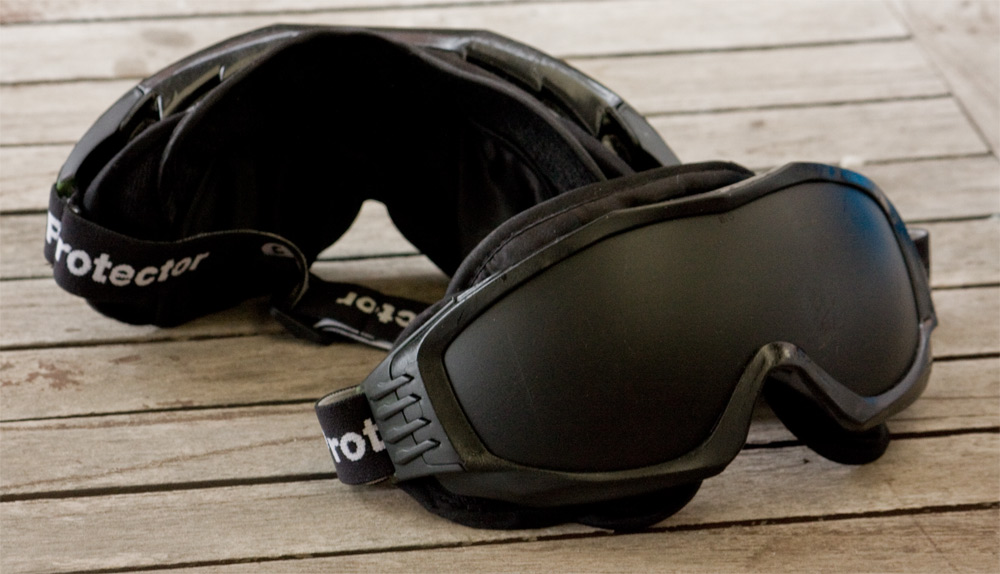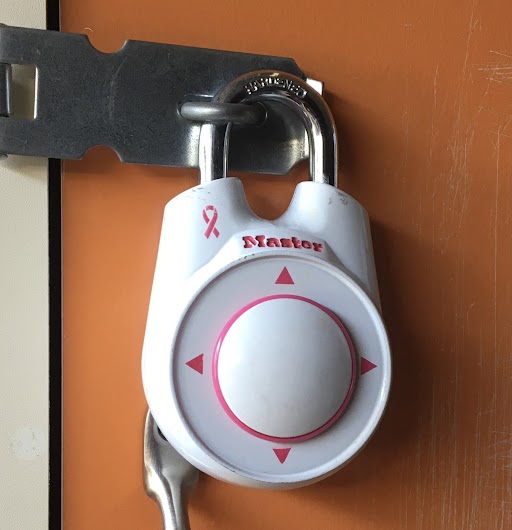Contents:
- Goggles or darkness?
- How to make comfy blackout googles
- Choosing a theme
- Rules and briefing
- Directional locks
- Hint system
- Waivers
Goggles or darkness?
The first design choice is whether you’re going to have your room in total darkness or have any players that do have sight wear blackout goggles. Note that it takes quite a bit of work to achieve total darkness. Light can leak in under doorframes or you may have electronic equipment with blinking LED lights – not to mention you’ll need to take this choice into your health and safety assessment.
For these reasons, The Owl Job opted to use goggles. For anyone who had some amount of vision, they had to don blackout goggles so that they would experience the room in total darkness.
The goggles need to be comfortable since you want players to forget they are wearing anything and just enjoy your game.
How to make comfy blackout googles
These are the goggles I built for The Owl Job.

Pictured: The front and back of a pair of goggles. The lenses are painted black and the insides are lined with plush fabric.
You can make these goggles yourself for about $20 in materials.
Materials:
- Goggles that enclose the entire eye area. Chemical goggles, worker safety goggles or welding goggles are good for this can be found at most hardware stores
- Sleeping masks (2 or 3 per pair) found at variety stores
- Black spray paint
- Optional: sealant spray (be sure to match your paint if you’re using acrylic paints or oil based paints)
- Glue suitable for plastics and fabrics
- Scissors
Method:
- Spray paint your goggles black. You may need to do this in a couple of layers.
- Optionally you can also add a layer of sealant to help protect the paint from wear and tear.
- Cut the elastic from the sleeping masks
- Once the paint is dry, glue the sleeping masks into place. You can to cover the tops, side and bottom of the goggles to provide a comfy fit that also creates a nice solid seal to block out light. Make sure you glue them down nice and firm against the inside of the lens so people don’t have to scrunch their eyes shut. They should be able to wear the mask, look around and blink, but not actually see anything while wearing the mask.
- Test it out! Invite a second opinion and make sure your design is both effective in blocking out light and comfortable. Remember, your players will likely wear this for a full hour.
Choosing a theme
The story of The Owl Job sees players taking on the role of burglars who are breaking into someone’s home in order to find and open the safe. One of the reasons we chose this story is because it gives players a familiar location (a house) and puts them in a position of power.
The house location was important since players could more easily identify objects they were familiar with. It didn’t take players long to recognise the fridge or the armchair by touch alone.
Giving players a powerful role was important to let them know they were in control of the space since they were trusting me as the game runner to put on blackout goggles and step into an unfamiliar space.
That’s not to say that you can’t set your sightless escape room set on an alien spacecraft or deliver a blood chilling horror experience. I would love to play those games. You just need to make sure players know what they’re in for and set their expectations accordingly.
Rules and briefing
When players entered the venue for The Owl Job the briefing for the most part was like any other. I told players where the bathrooms were, that we don’t actually lock players in for safety reasons and so on. But there are a number of items in the briefing that were unique to sightless escape rooms.
- Player Communication: This is more vital than ever in a sightless escape room. Talking helps you locate each other in the room, and you should try to describe the things that you find. Saying “I’ve found a metal triangle here” is more useful than just saying “I’ve found a thing here.”
- No running: You have a full hour, so you don’t need to run around the room. We don’t want anyone colliding at full speed.
- No crawling, climbing or moving furniture: Nothing is hidden under the rugs or behind the furniture. Essentially nothing important is below knee level.
- The Center Table: There’s a round table in the center of the room that’s a useful place to put things down. This is preferable to just pocketing items, since items in pockets effectively cease to exist for the other players in the room.
- Shoes: Players were informed in advanced to wear close toed shoes (no sandals/bare feet) to avoid any stepped on toes.
Directional locks
There were also two items that were unique to The Owl Job. Some of our puzzles used directional padlocks, so we had to brief players on these. These are locks that move in four directions: up, down, left, right. The important detail was that players needed to know to squeeze the clasp twice to clear the previous entry. We had a sample padlock that could be passed around so players were familiar with it.

Image: A directional padlock as described above.
Hint system
The other unique feature was our voice activated help system. We told players that if they did get stuck, there was a voice activated phone in the room and they could just say “call the locksmith” and the phone would connect them to someone who could help.
Waivers
Players were also given waivers in large text, small text, Braille as well a digital version. Click here for more information on the waivers.